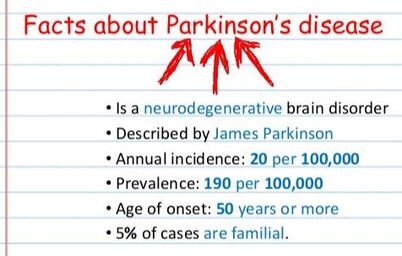Facts About Parkinson's

Over a million Americans live with Parkinson’s disease (PD) with over 60,000 new cases diagnosed each year. This is more than the combined number of people diagnosed with multiple sclerosis, muscular dystrophy and Lou Gehrig’s disease with Parkinson’s as the second most common neurodegenerative disorder following Alzheimer’s. While the actual number of individuals in Monterey County diagnosed with PD is difficult to determine, based on the County’s population statistics, the estimated number of patients diagnosed is well over 1,500.
A diagnosis of Parkinson’s disease is life changing but there is much that can be done in terms of incorporating daily exercise and disease-specific neuroplasticity-principled programs that improve symptoms, restore function and increase quality of life. Exercise benefits a Parkinson’s patient with symptom management. Research has proven that specific programs can improve gait, balance, tremor, flexibility, grip strength and motor coordination.
After an extensive assessment of resources in the current local landscape for those diagnosed with PD, it became clearly evident that the Monterey Peninsula is lacking an environment that supports long-term, ongoing and frequent movement programs which evidence-based research has proven to slow disease progression. The inaccessibility of local programs forces those patients seeking to improve symptom management through targeted exercise programs to travel several hours each week outside of the local geographical area to attend classes. Those patients who do not have the time flexibility or economic resources to travel outside of the area have limited ability to access opportunities for symptom improvement through movement.
A diagnosis of Parkinson’s disease is life changing but there is much that can be done in terms of incorporating daily exercise and disease-specific neuroplasticity-principled programs that improve symptoms, restore function and increase quality of life. Exercise benefits a Parkinson’s patient with symptom management. Research has proven that specific programs can improve gait, balance, tremor, flexibility, grip strength and motor coordination.
After an extensive assessment of resources in the current local landscape for those diagnosed with PD, it became clearly evident that the Monterey Peninsula is lacking an environment that supports long-term, ongoing and frequent movement programs which evidence-based research has proven to slow disease progression. The inaccessibility of local programs forces those patients seeking to improve symptom management through targeted exercise programs to travel several hours each week outside of the local geographical area to attend classes. Those patients who do not have the time flexibility or economic resources to travel outside of the area have limited ability to access opportunities for symptom improvement through movement.

